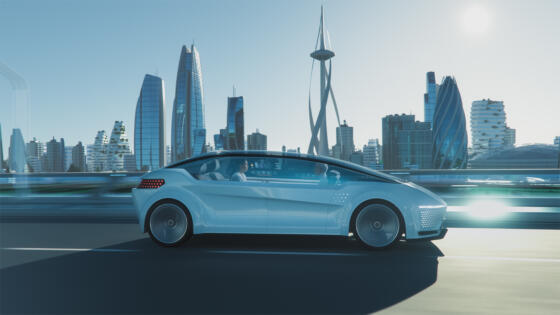Next stop: airspace
Wherever the vehicle shows up onlookers are awestruck. In a manner of speaking, the Land Aircraft Carrier hauls the future. The mini truck that despite its three axles is suitable for parking in underground garages carries a compact electric multicopter piggyback-style. Unloading is accomplished fully automatically. After unfolding its six rotors it’s ready for takeoff in just five minutes. One battery charge of the aircraft is said to suffice for up to five short airborne trips. That’s how AeroHT, a subsidiary of electric carmaker Xpeng, envisions the future of mobility.
That future is just around the corner, meaning truly just around the corner. AeroHT says that the company has received more than 2,000 orders for the Land Aircraft Carrier. The first models are scheduled for delivery in 2026. The next steps will be urban airports dedicated to serving as airspace/road hubs and a car that due to roof-mounted folding rotors mutates into a helicopter. Of course, that happens in fully electric mode as well. That AeroHT refers to these vehicles as flying cars more than clearly shows that this is about the next level of driving.
Why is that relevant for Schaeffler? Because the globally operating motion technology company has signed a forward-thinking collaboration agreement to produce electric drive systems for flying cars with the flying car pioneer from Guangzhou, China, at the beginning of the year.
“The airborne electric drive imposes extremely stringent requirements in respect of safety, reliability and weight,” emphasizes Klaus Rosenfeld, the CEO of Schaeffler AG. Exactly that’s where the Chinese company obviously sees a benefit in collaborating with the corporation headquartered in Herzogenaurach, Germany.

“As our Chinese customer put it, Schaeffler’s expertise and experience in the aerospace segment and in electric drivetrains for cars means that it has the potential, in this new form of mobility as well, to play a key role in the development and production of efficient and reliable electric drive systems.”
In addition to the know-how in the aerospace sector that the company has accumulated in several decades, Schaeffler has extensive quality certificates satisfying the stringent safety regulations in the industry. That, combined with its expertise in the field of electric drive systems, makes Schaeffler a preferred partner in the forward-looking sector of urban air mobility aka low-altitude economy. Zhao Deli is convinced of Schaeffler’s strengths as well. The founder and president of Xiaopeng Huitian, which is AeroHT’s real company name, says, “Our cooperation in the field of flight power will give full play to each other's advantages and jointly promote the rapid development of new quality productivity.”
Dr. Zhang Yilin, the CEO of Schaeffler China, regards the collaboration as a positive, pioneering project too: “Xiaopeng Huitian (Xpeng AeroHT) is a representative company in the field of low-altitude economy. We are very pleased to establish a cooperative relationship with Xiaopeng Huitian and support it in developing safe and reliable flying cars. As a technology company focusing on drive technology, we hope to give full play to our innovative capabilities and technological advantages in the field of drive technology, provide customers with innovative products and high-quality services, and work together to promote the commercial development of the low-altitude economy."
New mobility calls for bold ideas
Will flying cars truly gain traction? That question has not been answered yet. Aside from the costs, the technical potential as well as legal regulations and social acceptance are crucial factors. In a position paper on Urban Air Mobility, the German Aerospace Center DLR in the fall of 2024 wrote, “It has been shown that UAM might complement existing transportation systems in the future. Ultimately, it is a matter of the constituent systems working together in a way that the overall system is both economically feasible and socially acceptable.” If all the parameters are right, air taxi transportation using commercial flying cars could significantly increase starting in 2045 with up to 190 million flights per day by 2050, distributed to 200 metropolitan regions focused on Asia, Oceania, Europe, and North America, according to a DLR best-case forecast. In a worst-case scenario, the sector will literally remain ground-bound with a six-digit number of daily flights worldwide. That means a wide spread of prospects – and an equally high level of suspense.
Schaeffler’s CEO Klaus Rosenfeld puts it this way, “Naturally, we do not yet know whether flying cars will become established. But it is conceivable.” The reason is that the course has been set: In Shanghai, said Schaeffler’s CEO at the corporation’s general meeting in late April, 300 urban takeoff and landing facilities are currently in the making.

“Regardless of how the flying car evolves,” says Rosenfeld, “for us it is clear – as shown by the example from Guangzhou – that the future belongs to those companies that think outside the box in a customer-focused way, that know what they are capable of, that help shape new developments openly and boldly while at the same time remaining conscious of their roots.”




